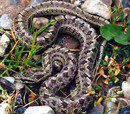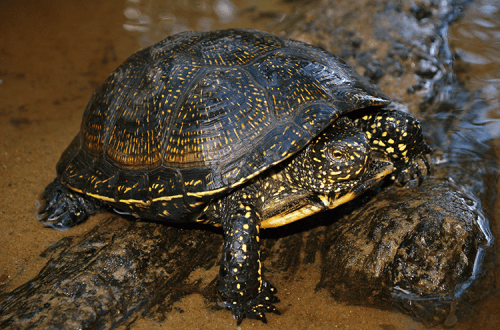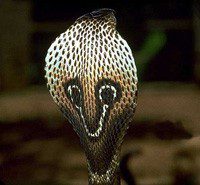
Indian cobra
The Indian cobra is a relative of the famous snakes Naga and Nagaina, described in Kipling’s fairy tale “Rikki-Tikki-Tavi”. In another way, it is called a spectacle snake because of the pattern in the form of two rings with a bow on the back of the hood. This hood is an individual feature of all known cobras. It is actually just a section of the neck that swells up under the action of certain muscles when the snake is frightened or aggressive. There are many legends associated with the Indian cobra. For example, they say that her “glasses” are the fingerprints of the Buddha. So in some parts of India the snake is considered a sacred animal. It is the Indian cobra that snake charmers use in their performances, demonstrating the famous hypnotic “cobra dance”. But for all its legend, this snake is incredibly dangerous and just as incredibly beautiful. Its poison contains substances that depress the nervous system of living beings. It is believed that even one gram of this poison is capable of destroying 140 dogs. And the spectacle pattern on the hood of the Indian cobra easily confuses any predator that comes up behind it. It comes out especially brightly when the snake is preparing to defend itself. However, the Indian cobra in nature also has enemies that are insensitive to its poison. These are the same mongooses mentioned by Kipling.
Other names.
Naja naja – lat. the name of a species of Indian cobra.
Cobra – General English, French, Italian, Spanish. name of the genus cobra
Spectacle snake.
Classification.
Kingdom: Animalia (animals)
Type: Chordata
Class: Reptilia (reptiles)
Order: Squamata (scaly)
Suborder: Serpentes (snakes)
Family: Elipidae (aspididae)
Genus: Naja (real cobras)
Species: Naja naja (Indian cobra or spectacled snake)
Subspecies: monocle cobra (Naja naja kaouthia), Central Asian cobra (Naja naja oxiana), Indian spitting cobra (Naja naja sputatrix), blind cobra (Naja naja coeca), Taiwanese cobra (Naja naja atra) and others, about 10 subspecies are known in total .
habitation.
Most often, the Indian cobra is found in South Asia and on the African mainland. The monocle cobra subspecies, so called because of the pattern on the hood in the form of a single ring, lives in the southern part of Central Asia, in eastern Iran, in Afghanistan, Pakistan, India and on the island of Sri Lanka. Also, the habitat of this snake spreads throughout Southeast Asia, reaching South China and the island of Taiwan and covering all the Sunda and Philippine Islands. The latitudes of our country are characterized by a subspecies of the Central Asian cobra, which inhabits the territories of southern Turkmenistan, southern Uzbekistan and southwestern Tajikistan. The Central Asian subspecies of the Indian cobra prefers to live in the foothills, not rising high, but living on hills with sparse grassy vegetation and many holes and stone blockages where you can hide. In Central Asia, the Indian cobra chooses places near water or mountain gorges. And she also willingly settles next to human habitation, for example, in the ruins of old houses, in cemeteries and even in populated villages. However, it can be found with the same success in the arid territories of the Asian deserts far from water bodies. Actually, the Indian cobra, that is, its nominal subspecies that lives in India, Ceylon and Pakistan, chooses a variety of places to live – the ruins of buildings, tree roots, termite mounds and ravines. She is also not afraid of the closeness of a person. The Indian cobra can settle in the city, and in the garden, and in the rice field, and in the mountains up to 2700 meters above sea level. The spitting Indian cobra is a resident of Southeast Asia, the Lesser Sunda and Philippine Islands, in particular, the islands of Java and Celebes. Other subspecies that can “shoot” poison are found in the Malay Islands.
Description.
 Many legends and stories owe the Indian cobra, including its amazing appearance. She is very colorful. The predominant color is bright yellow with a bluish tinge, visible in sunlight. In different subspecies of the snake, the body color can vary from yellow-gray to brown, and completely black snakes come across. The ventral part of the body is noticeably lighter – yellow-brown or gray. In young Indian cobras, horizontal wide dark stripes are visible on the skin. As the snake matures, they disappear. The body length of the Indian cobra is one and a half – two meters. Its rounded and slightly flattened head is integral with the body. The eyes of the Indian cobra are medium-sized, with a round pupil. Large skin shields are located on the head, and the body is long and thinning towards the tail, completely covered with smooth, gleaming scales.
Many legends and stories owe the Indian cobra, including its amazing appearance. She is very colorful. The predominant color is bright yellow with a bluish tinge, visible in sunlight. In different subspecies of the snake, the body color can vary from yellow-gray to brown, and completely black snakes come across. The ventral part of the body is noticeably lighter – yellow-brown or gray. In young Indian cobras, horizontal wide dark stripes are visible on the skin. As the snake matures, they disappear. The body length of the Indian cobra is one and a half – two meters. Its rounded and slightly flattened head is integral with the body. The eyes of the Indian cobra are medium-sized, with a round pupil. Large skin shields are located on the head, and the body is long and thinning towards the tail, completely covered with smooth, gleaming scales.
The Indian cobra earned the nickname of the spectacle snake due to the light pattern on the back of the neck, reminiscent of antique glasses. When the snake is frightened or defensive, it raises the front of the torso to a vertical position, and the cobra’s head balances against the enemy. The hood appears due to 8 pairs of front ribs, which at this moment are parted to the sides. The hooded part of the body immediately noticeably expands and flattens, and the glasses clearly show through on the skin. As already mentioned, in the subspecies of the monocle cobra, the spectacle pattern consists of one ring, while in the Central Asian subspecies it is completely absent.
With all the seeming grace, the Indian cobra is quite clumsy and clumsy. However, she swims, dives and moves along the branches of trees perfectly. A pair of the famous poisonous fangs of the Indian cobra is located on the upper jaw, followed by an empty gap, and then a few (1-3) small teeth. However, this snake, unlike its other relatives, does not bite often. She prefers to scare off the enemy with a loud hiss and impressive appearance, without waiting for him to approach or touch her. But even with direct contact with the enemy, the Indian cobra is able to first inflict a fake bite by hitting the enemy with its head. The thing is that the teeth of this snake are shorter than, say, those of vipers, so for a full-fledged bite, it has to firmly cling to the victim with its teeth and squeeze them several times in order to accurately bite and inject poison. And the teeth of the Indian cobra are easy enough to break, but new ones quickly grow in their place. In fact, it is quite difficult to turn under the bite of this snake in nature, only if you specifically run into it. In reality, Indian cobras rarely attack humans.
Of particular interest to scientists is such a subspecies of the Indian cobra as spitting. This snake really has an original way to attack. It is capable of spraying poison towards the enemy at a distance of up to 2 meters. This feature operates due to the special structure of the poisonous fangs, the venom-conducting channel in which is not directed downward, as in other representatives of the aspid family, but forward – perpendicular to the front side of the canine. A sharp contraction of the muscles helps the spitting cobra shoot venom through these holes. The spitting Indian cobra is highly accurate. She directs a stream of poison into the eyes of an enemy, but more often uses this skill against large opponents. Such a “shot” can lead to complete blindness if the eyes are not rinsed in time.
Food.
Different subspecies of cobras hunt at different times of the day: some in the evening and late at night, others on spring days during the period of greatest activity. On especially hot summer days, the Indian cobra goes out for prey in the early morning, when the sun has not yet begun to burn. Its main food is amphibians (toads and frogs), small lizards and other reptiles, as well as rodents – mice and rats. If, in search of food, a snake finds a bird’s nest, then it will certainly be ruined. And it is no coincidence that the Indian cobra settles next to people. So she provides herself with a plentiful diet, thanks to the rodents living next to a person, as well as the eggs of poultry. The Indian cobra is quite capable of plundering a chicken coop. She hunts fish in the water. But even without water it can do for a long time, for several weeks and even months, although if there is a reservoir nearby, it drinks a lot and willingly.
Breeding.
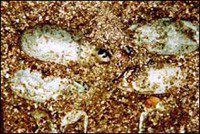 The nominal subspecies of the Indian cobra is characterized by better fertility than the Central Asian. There is affection between individuals of different sexes, the female and male stay together not only during the mating season, but also after fertilization, until the birth of the young. The mating season for Indian cobras begins in winter, and they make clutches in late spring and protect it with joint efforts. But more often, the female guards her offspring, of course. True, unlike royal cobras, Indian cobras do not incubate eggs, warming them with their warmth. However, the spectacled snake also carefully prepares for the birth of offspring, choosing a suitable warm place for the nest, and then protecting it with all the courage that it is capable of. It is better not to disturb the Indian cobra guarding eggs, during this period it is especially dangerous. In one clutch of the Indian cobra, there are about 10-20 eggs, but it happened to find larger clutches – up to 45 eggs in the nest. After 2, 5 – 3 months, small snakes appear from the eggs, which are already poisonous, ready for defense and able to inflate their hood. In captivity, it is quite difficult to achieve breeding of the Indian cobra, not all zoos can boast of this, not to mention private owners of terrariums.
The nominal subspecies of the Indian cobra is characterized by better fertility than the Central Asian. There is affection between individuals of different sexes, the female and male stay together not only during the mating season, but also after fertilization, until the birth of the young. The mating season for Indian cobras begins in winter, and they make clutches in late spring and protect it with joint efforts. But more often, the female guards her offspring, of course. True, unlike royal cobras, Indian cobras do not incubate eggs, warming them with their warmth. However, the spectacled snake also carefully prepares for the birth of offspring, choosing a suitable warm place for the nest, and then protecting it with all the courage that it is capable of. It is better not to disturb the Indian cobra guarding eggs, during this period it is especially dangerous. In one clutch of the Indian cobra, there are about 10-20 eggs, but it happened to find larger clutches – up to 45 eggs in the nest. After 2, 5 – 3 months, small snakes appear from the eggs, which are already poisonous, ready for defense and able to inflate their hood. In captivity, it is quite difficult to achieve breeding of the Indian cobra, not all zoos can boast of this, not to mention private owners of terrariums.
Keeping.
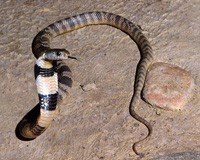 The Indian cobra is so dangerous that it is unlikely to be found in private collections of terrariumists. Scientists prefer to observe this snake in nature reserves and rarely in zoos. But if we talk about the arrangement of the terrarium, then for an Indian cobra one and a half meters in size, it should be at least 100x80x60 cm. Another important point is maintaining the right temperature. This can be achieved by underfloor heating. And of course, the Indian cobra, even in a limited space, needs shelter, for example, some plants, under the roots of which you can climb, or specially adapted boxes. Small rodents can be used as live food for the Indian cobra, as well as fish, pieces of meat and other sources of animal protein. And yet, we repeat once again, keeping poisonous snakes in captivity is very dangerous.
The Indian cobra is so dangerous that it is unlikely to be found in private collections of terrariumists. Scientists prefer to observe this snake in nature reserves and rarely in zoos. But if we talk about the arrangement of the terrarium, then for an Indian cobra one and a half meters in size, it should be at least 100x80x60 cm. Another important point is maintaining the right temperature. This can be achieved by underfloor heating. And of course, the Indian cobra, even in a limited space, needs shelter, for example, some plants, under the roots of which you can climb, or specially adapted boxes. Small rodents can be used as live food for the Indian cobra, as well as fish, pieces of meat and other sources of animal protein. And yet, we repeat once again, keeping poisonous snakes in captivity is very dangerous.
Advanced.
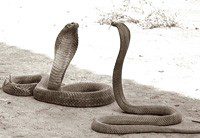 In India, cobras are treated not only with fear, but with real reverence and reverence. Hindus bow before her as before a deity and, having found an Indian cobra in their house, in every possible way coax and even feed her. It is not surprising that with such an attitude, quackery associated with the performances of snake charmers is widespread in India. These people train the Indian cobra, accustoming it to certain movements and sounds, and over time the snake begins to demonstrate a kind of dance to the music. It is said that unscrupulous spellcasters simply break out the poisonous teeth of the snake. However, researchers have determined that most of these trainers still know how to handle poisonous Indian cobras without resorting to any violence.
In India, cobras are treated not only with fear, but with real reverence and reverence. Hindus bow before her as before a deity and, having found an Indian cobra in their house, in every possible way coax and even feed her. It is not surprising that with such an attitude, quackery associated with the performances of snake charmers is widespread in India. These people train the Indian cobra, accustoming it to certain movements and sounds, and over time the snake begins to demonstrate a kind of dance to the music. It is said that unscrupulous spellcasters simply break out the poisonous teeth of the snake. However, researchers have determined that most of these trainers still know how to handle poisonous Indian cobras without resorting to any violence.
Sources.
http://ru.wikipedia.org
http://www.floranimal.ru
http://www.alins.ru
http://www.mad-love.ru
http://heralblog.ru
http://www.povodok.ru
Home
http://aquaria.ru/
http://dic.academic.ru
http://zoo-dom.com.ua



